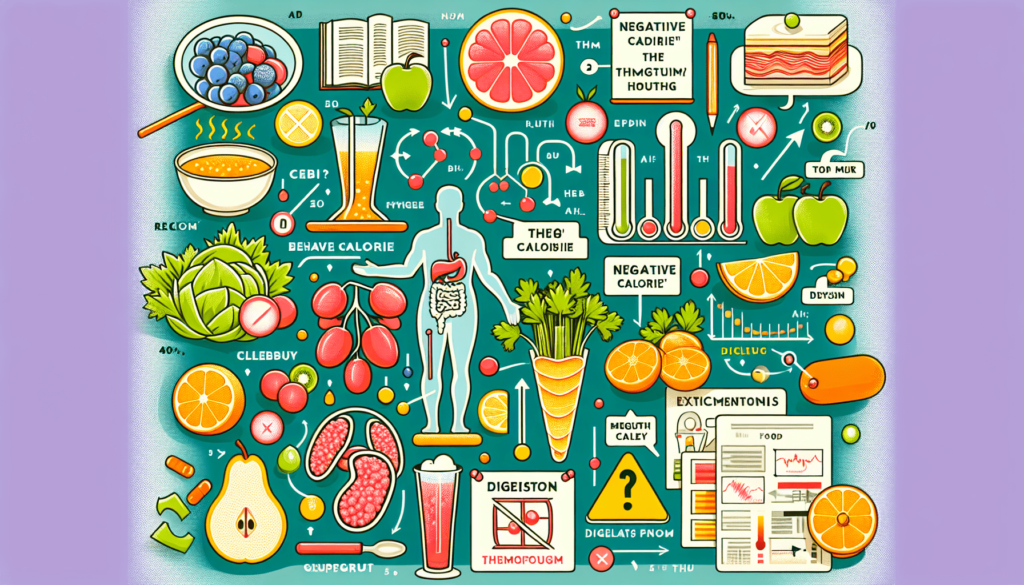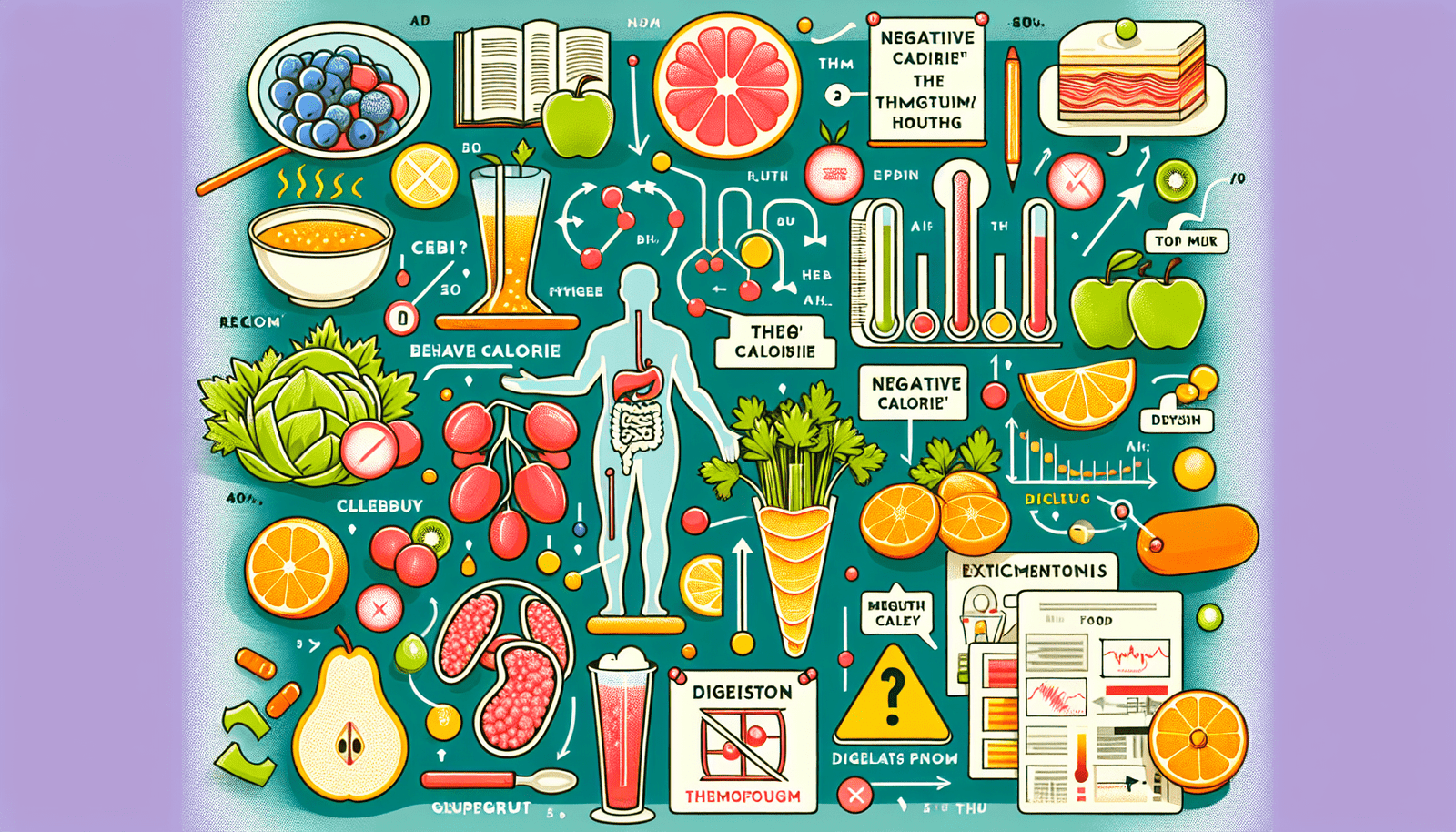Imagine if there were foods out there that could magically burn more calories when you eat them than they actually contain. Sounds like a dream come true, right? Well, unfortunately, the concept of “negative calorie” foods is nothing more than a myth. Despite all the buzz surrounding these so-called miracle foods, the truth is that our bodies don’t operate on magic when it comes to calories. In this article, we will debunk the myth of negative calorie foods and shed light on the truth behind this alluring idea. So, prepare to sift through the mix of facts and fiction, and let’s demystify the world of these so-called negative calorie foods together.
What are “Negative Calorie” Foods?
Definition
Negative calorie foods are often claimed to be foods that require more energy to digest than the actual calories they provide. This means that the body burns more calories during the digestion process of these foods than the calories they contribute, ultimately leading to a negative net calorie effect.
Examples
Common examples of foods that are often touted as negative calorie foods include celery, grapefruit, and cucumbers. These foods are claimed to have such low caloric content and high fiber content that the body supposedly expends more energy breaking them down than the calories they contain.
Understanding Caloric Intake and Expenditure
Basal Metabolic Rate
The basal metabolic rate (BMR) refers to the number of calories your body needs to perform basic functions while at rest. It encompasses the energy needed for vital processes such as breathing, circulating blood, and maintaining body temperature. BMR can vary depending on factors such as age, weight, gender, and genetics.
Thermic Effect of Food
The thermic effect of food (TEF) refers to the energy required for the digestion, absorption, and transport of nutrients. It accounts for approximately 10% of the total calories consumed in a day. The TEF varies depending on the macronutrient composition of the food, with protein having the highest thermic effect followed by carbohydrates and fats.
Physical Activity
Physical activity is an essential component of caloric expenditure. It includes intentional exercise as well as everyday movements such as walking, climbing stairs, and even fidgeting. The level of physical activity varies among individuals and greatly contributes to the total calories burned in a day.
Overall Energy Balance
The overall energy balance is the relationship between caloric intake and expenditure. It is the key determinant of weight management. When caloric intake exceeds expenditure, the body stores the excess energy as fat, leading to weight gain. Conversely, when caloric expenditure exceeds intake, the body utilizes stored energy, resulting in weight loss.

The Theory Behind ‘Negative Calorie’ Foods
Explanation of the Theory
The theory behind negative calorie foods suggests that certain foods have such low caloric content that the body expends more energy breaking them down and digesting them than the calories they provide. This would theoretically lead to an energy deficit and negative net calorie effect.
Claimed Benefits of Negative Calorie Foods
Advocates of the negative calorie food concept argue that including these foods in your diet can accelerate weight loss, boost metabolism, and provide a sense of fullness while consuming fewer calories. It is also believed that by incorporating negative calorie foods, one can achieve a healthier and more sustainable approach to weight management.
Scientific Evidence and Research
Lack of Scientific Basis
Despite the widespread belief in negative calorie foods, there is a lack of scientific basis to support this concept. The energy expended in digestion is typically a fraction of the energy content of the food consumed, making it unlikely for any food to have a negative net calorie effect.
Studies Debunking the Theory
Several studies have aimed to investigate the theory of negative calorie foods and have consistently debunked its validity. One study published in the Journal of the Academy of Nutrition and Dietetics concluded that the thermic effect of food is generally minimal and insufficient to result in a negative energy balance.

Metabolism and Caloric Equivalents
Metabolic Process of Digestion
During the metabolic process of digestion, the body breaks down food into simpler forms to release energy. The macronutrients, carbohydrates, proteins, and fats, are eventually converted into glucose, amino acids, and fatty acids, respectively, for energy utilization.
Energy Extraction from Different Nutrients
Carbohydrates provide approximately 4 calories per gram, while both proteins and fats provide around 9 calories per gram. These caloric values are consistent across different foods and nutrients. Thus, the idea of certain foods having a negative caloric value contradicts the established energy content of macronutrients.
Caloric Content of Common ‘Negative Calorie’ Foods
Contrary to popular belief, even foods commonly referred to as negative calorie foods, such as celery and cucumbers, still contain at least minimal calories. For instance, celery has approximately 6 calories per stalk, while cucumbers contain around 45 calories per large cucumber. These values further emphasize the impracticality of negative calorie foods.
Role of Exercise and Physical Activity
Effects on Caloric Expenditure
Engaging in exercise and physical activity increases caloric expenditure, thereby contributing to weight management. Moderate-intensity activities such as brisk walking, cycling, or swimming can burn a significant number of calories, depending on the duration and intensity of the activity.
Importance of Overall Energy Balance
Although exercise and physical activity do play a crucial role in caloric expenditure, it is essential to recognize that they are just one component of the overall energy balance equation. Balancing caloric intake through proper nutrition is equally important for achieving and maintaining a healthy weight.
Compensatory Mechanisms
It is worth noting that engaging in exercise and physical activity can lead to increased appetite and subsequent compensatory eating. This compensatory mechanism may reduce the potential impact of exercise on weight loss if caloric intake exceeds the calories burned through physical activity.
Nutritional Value of “Negative Calorie” Foods
Vitamins and Minerals
While the negative calorie concept may lack scientific basis, it is important to acknowledge that many of the foods commonly associated with it, such as fruits and vegetables, are indeed rich in vitamins and minerals. Incorporating these foods into a balanced diet can promote overall health and well-being.
Fiber Content
Foods often labeled as negative calorie foods, such as celery and leafy greens, are typically high in fiber. Fiber plays a crucial role in digestive health, promoting satiety, and aiding in weight management. However, the fiber content alone cannot offset the caloric content of these foods.
Other Health Benefits
In addition to their vitamin, mineral, and fiber content, many foods associated with the negative calorie concept also provide other health benefits. For example, citrus fruits are a good source of antioxidants, while leafy greens are rich in phytonutrients. These foods contribute to a well-rounded and nutritious diet.
Healthy Weight Loss Strategies
Balanced Diet
Adopting a balanced diet that includes a variety of nutrient-dense foods is vital for long-term weight management. This includes consuming adequate amounts of lean protein, whole grains, fruits, vegetables, and healthy fats while limiting the intake of highly processed foods, added sugars, and unhealthy fats.
Moderate Caloric Deficit
Creating a moderate caloric deficit is a sustainable approach to weight loss. Aim for a gradual and steady weight loss of 1-2 pounds per week, which generally requires a caloric deficit of 500-1000 calories per day. This can be achieved by a combination of reducing caloric intake and increasing physical activity.
Physical Activity
Regular physical activity not only contributes to overall calorie expenditure but also improves cardiovascular fitness, muscle strength, and flexibility. Engage in a mix of cardiovascular exercises, strength training, and flexibility exercises to achieve optimal health and weight management.
Sustainable Lifestyle Changes
Incorporating sustainable lifestyle changes is crucial for long-term weight management. Focus on adopting healthy habits such as mindful eating, portion control, and regular exercise, rather than relying on quick fixes or fad diets. Making gradual, sustainable changes ensures that weight loss is achieved in a healthy and maintainable manner.
Potential Risks and Pitfalls
Nutritional Deficiencies
Relying solely on foods that are believed to have a negative calorie effect may lead to nutritional deficiencies. These foods often lack essential nutrients such as protein, healthy fats, and certain vitamins and minerals that are necessary for overall health. It is important to consume a diverse range of foods to meet your nutritional needs.
Unrealistic Expectations
Believing in the concept of negative calorie foods can create unrealistic expectations for weight loss. It is important to understand that sustainable weight loss requires a combination of a balanced diet, physical activity, and lifestyle changes. Expecting negative calorie foods to be a magic solution can lead to disappointment and frustration.
Disordered Eating Patterns
Placing too much emphasis on the negative calorie concept can potentially contribute to disordered eating patterns. Obsessive calorie counting and restrictive eating habits can negatively impact both physical and mental health. It is crucial to adopt a balanced and holistic approach to food and nutrition.
Effects on Metabolism
Extreme caloric deficits caused by excessive reliance on negative calorie foods may lead to a decrease in metabolic rate. The body enters a state of energy conservation, slowing down various physiological processes in an effort to preserve energy. This can hinder weight loss efforts in the long run and make it harder to maintain a healthy weight.
Conclusion
Disproving the ‘Negative Calorie’ Myth
The concept of negative calorie foods, while popular in the realm of weight management, lacks scientific evidence. Numerous studies have debunked the theory and emphasized the importance of overall energy balance in weight management. The energy expended during digestion is typically minimal and insufficient to result in a negative net calorie effect.
Promoting Balanced and Evidence-Based Approaches
To achieve sustainable weight loss and overall health, it is crucial to focus on evidence-based strategies. A balanced diet, moderate caloric deficit, regular physical activity, and sustainable lifestyle changes are key components of a successful weight management plan. Relying on the concept of negative calorie foods may lead to unrealistic expectations and potentially harmful eating patterns. It is essential to promote balanced and evidence-based approaches to help individuals achieve and maintain a healthy weight.

